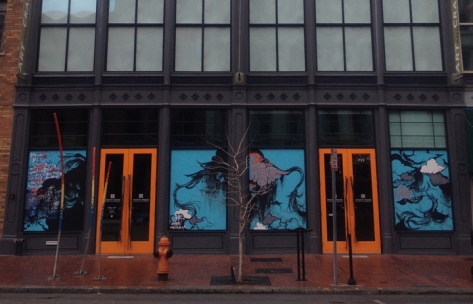
Graffiti: noun
- Writing or drawings scribbled, scratched, or sprayed illicitly on a wall or other surface in a public place
If you’ve walked or driven by KMAC in recent days, you might have noticed something startlingly different about the museum. While Sofia Maldonado’s paintings on the museum are not graffiti because it is not an act of defiance by an individual on a public space, her works illustrate one of the many ways in which a museum can interact and provide a platform for visual artists. West Main Street, Louisville, Kentucky became her studio for 3 days as she completed her work with the help of assistants. Sofia, who hails from Puerto Rico and divides her time now between NYC and Puerto Rico, added text inspired by her interactions with people in Louisville as she asked for comments from passerbys. Staff and visitors of the coffee shop across the street enjoyed seeing the work unfold real-time. Her work is also a form of performance or “artist as laborer working in Kentucky” that is specifically relevant in a process oriented craft context that defines the museum’s mission.

Artists interacting with the exterior of a museum space are not new to the artworld. Christo and Jean-Claude wrapped the Kunsthalle Bern in a show curated by Harald Szeeman in 1967-1968, and they also wrapped the exterior and interior of The Museum of Contemporary Museum of Chicago in 1968-1969. These acts question the framework of a museum as it becomes a large sculpture shrouded with tarp and rope. In 2000 artist Shimon Attie projected An Unusually Bad Lot, on the ICA in Boston. One component of his exhibition was to comb the archives of the building and project the results from across the street during the evening hours. The images were derived from the previous owner of the museum space, the Boston Police Department, and the criminals jailed there. Attie memorialized past inhabitants that helped define the architecture of the art space with the idea that vestiges of previous functions are bound to define future uses and interactions with the public.

Similar to Maldonado, Attie’s museum became the screen for his artwork, but with Christo and Jean-Claude, the museum was the skeleton that held up the work. The museum was integral in the completion of the work. Visitors expect to view art and obviously, the museum interior walls help to display the works. By painting on the windows of the museum in an unexpected public area, the museum is trying to question our expectations and convention which is an important reason for art and craft to exist in the first place.
Do you have any other examples of artists painting, projecting, wrapping or building on the outside of a museum space?
